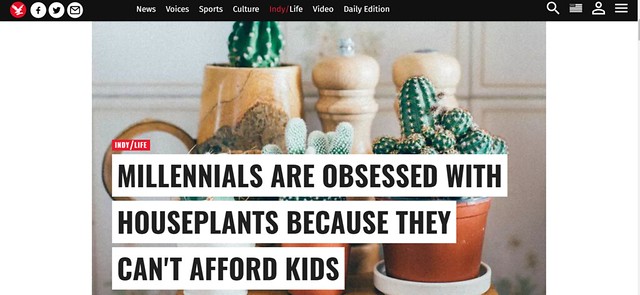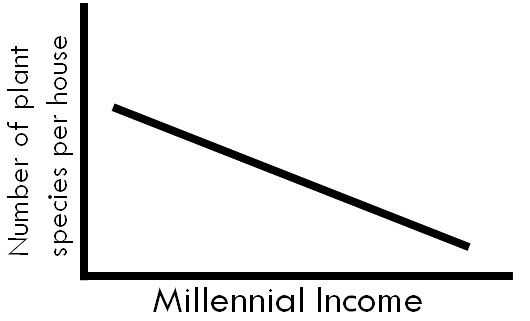Evan Kuras OUR ECOSYSTEMS
biodiversity species plant conservation cities botany health
Money Doesn’t Grow on Monsteras: The Economics of Indoor Plants
If you love planty puns and awesome alliterations, you need to spend more time on Instagram. From #plantshelfie to #monsteramonday, Instagram has it all (Fig. 1). Journalists have noticed: In Cosmopolitan and the New York Times, for example, you can read how indoor plants and the #plantfluencers are changing the nature of life indoors.
Fig. 1 - A delightfully lush Monstera plant featured on #monsteramonday (source: onlinehouseplants via Instagram)
But editors from the style section aren’t the only ones following the boom in indoor gardening. Ecologists, economists, and health professionals also care about how plants are distributed in cities, how individuals choose to spend their money, and how those choices affect human health and well-being. Here’s the thing: indoor environments are important sources of biodiversity that people experience in their day-to-day lives. And unlike the outdoor biodiversity that is easily overlooked on your commute or that you see while playing Pokémon Go, indoor biodiversity can provide health and well-being benefits that extend beyond making your friends jealous of your green thumb.
If plants are so great, why don’t we all have homes full of plants? In a past TLS post I pitched three reasons why some homes are plantier than others. Essentially, people make decisions about plants: (1) to uphold or signal a desirable social status, (2) for edible or medicinal purposes, or (3) in relation to available resources (water, time, space, etc.). Of course, some people just love plants (especially those cool cacti and succulents) while others are totally uninterested in gardening. And then there’s that niche group that only selects plants with intriguing latin names…
Much of what scientists know about residential plant diversity comes from research about outdoor plants. After all, it is a lot easier to survey the diversity of plants along a street or in a person’s yard or garden; entering a home to catalog their plants is a bit more… intrusive. But our knowledge about indoor environments is improving. For example, at North Carolina State University (NCSU), Rob Dunn’s lab runs numerous citizen science research projects about indoor biodiversity, from mites to microbes, where researchers ask volunteers to send in samples from their homes to the lab. You can participate in many of these projects too (especially if you bake your own bread or wear clothing)!
For my Masters research, I studied how economics influence biodiversity in different cities throughout the world. Often, wealthier households or neighborhoods tend to have a greater diversity of plants and animals. One of the first studies on the topic took place in Phoenix, Arizona, and found a positive relationship between median family income and neighborhood (outdoor) plant diversity [1] (Fig. 2a). Since then, dozens of studies have found similar relationships between wealth and outdoor plant and animal diversity, but only one study (that I’m aware of) has focused on indoor biodiversity. Unsurprisingly, it was the Dunn Lab at NCSU that found a positive relationship between average neighborhood income and indoor arthropod diversity in Raleigh, North Carolina [2] (Fig. 2b).

Fig. 2 - In both Phoenix (left graph) and Raleigh (right graph), researchers found greater biodiversity in wealthier neighborhoods (source: [1] and [2]). Note that the graph on the right shows a trendline for three neighborhood “types” with different levels of local ground cover; researchers only found positive relationships in neighborhoods with low and medium ground cover for reasons that are interesting but not relevant to this post.
There are many reasons why researchers find positive relationships between wealth and outdoor biodiversity. For example, wealthier residents can afford to move to areas with more trees and parks, have larger yards, purchase and care for more plants, and so on. But the indoor environment is a different animal, so to speak. People have more control over how they decorate and can more easily do so within their means without being restricted by city ordinances or judgmental neighbors. It is therefore possible that the trends that apply to outdoor biodiversity do not apply indoors, or that indoor patterns have a different scientific basis. With so much to learn about the economics of indoor biodiversity, we’re fortunate that journalists are already making scientific predictions (Fig. 3).

Fig. 3 - The title of an Independent article about millennials and houseplants (source: Kashmira Gander via The Independent)
Let’s examine the hypothesis that millennials are obsessed with houseplants because they can’t afford kids [3]. In essence, the author predicts a negative relationship between income and indoor house plant diversity among millennials. Lower-income millennials that can’t afford kids should have more houseplants and higher-income millennials that can afford kids should have fewer houseplants. This sounds like a testable hypothesis to me! I even graphed the relationship in Fig. 4.

Fig. 4 - Hypothetical relationship between the household income of millennials and their indoor plant species diversity (source: Evan Kuras)
It will be interesting to see how this hypothesis and others hold up as we learn more about the economics of indoor plants. Could adorable houseplants truly replace children in millennial households? Is this only true for those posting all their plant pics to Instagram? Or are there other features affecting both indoor house plants and the desire to have kids, such as the high cost of rent in urban centers and a changing economy?
Often, journalists notice things before scientists do, or at least can observe, ask questions, and write about trends at a faster pace. And you can too! The next time you’re inside a planty house, ask your host how they make decisions about the plants they obtain and care for. Do they care about its cost? Or its geographic origin? Or whether it is compatible with #monsteramonday?
Comment below with the reasons why (or why not) you fill your home with different plants!
References
[1] Hope, Diane, et al. “Socioeconomics drive urban plant diversity.” Proceedings of the national academy of sciences 100.15 (2003): 8788-8792.
[2] Leong, Misha, et al. “Exoskeletons and economics: indoor arthropod diversity increases in affluent neighbourhoods.” Biology Letters 12.8 (2016)
[3] Gander, Kashmira. “The Sad Reason Millennials Are so Obsessed with House Plants.” The Independent, Independent Digital News and Media, 17 Nov. 2017, www.independent.co.uk/life-style/millennials-houseplants-children-kids-money-families-succulent-cactus-bonsai-how-to-dying-a7937021.html.
